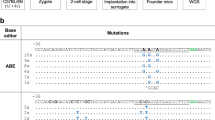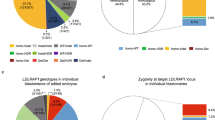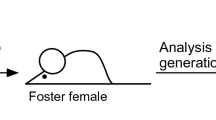Abstract
Genome editing holds great potential for correcting pathogenic mutations. We developed a method called GOTI (genome-wide off-target analysis by two-cell embryo injection) to detect off-target mutations by editing one blastomere of two-cell mouse embryos using either CRISPR–Cas9 or base editors. GOTI directly compares edited and non-edited cells without the interference of genetic background and thus could detect potential off-target variants with high sensitivity. Notably, the GOTI method was designed to detect potential off-target variants of any genome editing tools by the combination of experimental and computational approaches, which is critical for accurate evaluation of the safety of genome editing tools. Here we provide a detailed protocol for GOTI, including mice mating, two-cell embryo injection, embryonic day 14.5 embryo digestion, fluorescence-activated cell sorting, whole-genome sequencing and data analysis. To enhance the utility of GOTI, we also include a computational workflow called GOTI-seq (https://github.com/sydaileen/GOTI-seq) for the sequencing data analysis, which can generate the final genome-wide off-target variants from raw sequencing data directly. The protocol typically takes 20 d from the mice mating to sequencing and 7 d for sequencing data analysis.
This is a preview of subscription content, access via your institution
Access options
Access Nature and 54 other Nature Portfolio journals
Get Nature+, our best-value online-access subscription
$29.99 / 30 days
cancel any time
Subscribe to this journal
Receive 12 print issues and online access
$259.00 per year
only $21.58 per issue
Buy this article
- Purchase on Springer Link
- Instant access to full article PDF
Prices may be subject to local taxes which are calculated during checkout



Similar content being viewed by others
Data availability
The sequencing data were deposited in the National Center for Biotechnology Information’s Sequence Read Archive under project accession SRP119022 and http://www.biosino.org/node/project/detail/OEP000195.
Code availability
The GOTI-seq pipeline is publicly available in GitHub at https://github.com/sydaileen/GOTI-seq. The code in this protocol has been peer reviewed.
References
Knott, G. J. & Doudna, J. A. CRISPR–Cas guides the future of genetic engineering. Science 361, 866–869 (2018).
de la Fuente-Nunez, C. & Lu, T. K. CRISPR–Cas9 technology: applications in genome engineering, development of sequence-specific antimicrobials, and future prospects. Integr. Biol. 9, 109–122 (2017).
Hsu, P. D., Lander, E. S. & Zhang, F. Development and applications of CRISPR–Cas9 for genome engineering. Cell 157, 1262–1278 (2014).
Doudna, J. A. & Charpentier, E. Genome editing. The new frontier of genome engineering with CRISPR–Cas9. Science 346, 1258096 (2014).
Cox, D. B., Platt, R. J. & Zhang, F. Therapeutic genome editing: prospects and challenges. Nat. Med. 21, 121–131 (2015).
Musunuru, K. The hope and hype of CRISPR–Cas9 genome editing: a review. JAMA Cardiol. 2, 914–919 (2017).
Jiang, F. & Doudna, J. A. CRISPR–Cas9 structures and mechanisms. Annu. Rev. Biophys. 46, 505–529 (2017).
Wyman, C. & Kanaar, R. DNA double-strand break repair: all’s well that ends well. Annu. Rev. Genet. 40, 363–383 (2006).
Paquet, D. et al. Efficient introduction of specific homozygous and heterozygous mutations using CRISPR/Cas9. Nature 533, 125–129 (2016).
Komor, A. C., Kim, Y. B., Packer, M. S., Zuris, J. A. & Liu, D. R. Programmable editing of a target base in genomic DNA without double-stranded DNA cleavage. Nature 533, 420–424 (2016).
Nishida, K. et al. Targeted nucleotide editing using hybrid prokaryotic and vertebrate adaptive immune systems. Science 353, aaf8729 (2016).
Gaudelli, N. M. et al. Programmable base editing of A*T to G*C in genomic DNA without DNA cleavage. Nature 551, 464–471 (2017).
Rees, H. A. & Liu, D. R. Base editing: precision chemistry on the genome and transcriptome of living cells. Nat. Rev. Genet. 19, 770–788 (2018).
Pattanayak, V. et al. High-throughput profiling of off-target DNA cleavage reveals RNA-programmed Cas9 nuclease specificity. Nat. Biotechnol. 31, 839–843 (2013).
Zuo, E. et al. Cytosine base editor generates substantial off-target single-nucleotide variants in mouse embryos. Science 364, 289–292 (2019).
Jin, S. et al. Cytosine, but not adenine, base editors induce genome-wide off-target mutations in rice. Science 364, 292–295 (2019).
Grunewald, J. et al. Transcriptome-wide off-target RNA editing induced by CRISPR-guided DNA base editors. Nature 569, 433–437 (2019).
Zhou, C. et al. Off-target RNA mutation induced by DNA base editing and its elimination by mutagenesis. Nature 571, 275–278 (2019).
Cameron, P. et al. Mapping the genomic landscape of CRISPR–Cas9 cleavage. Nat. Methods 14, 600–606 (2017).
Frock, R. L. et al. Genome-wide detection of DNA double-stranded breaks induced by engineered nucleases. Nat. Biotechnol. 33, 179–186 (2015).
Tsai, S. Q. et al. GUIDE-seq enables genome-wide profiling of off-target cleavage by CRISPR–Cas nucleases. Nat. Biotechnol. 33, 187–197 (2015).
Tsai, S. Q. et al. CIRCLE-seq: a highly sensitive in vitro screen for genome-wide CRISPR–Cas9 nuclease off-targets. Nat. Methods 14, 607–614 (2017).
Madisen, L. et al. A robust and high-throughput Cre reporting and characterization system for the whole mouse brain. Nat. Neurosci. 13, 133–140 (2010).
Wang, L. et al. CRISPR–Cas9-mediated genome editing in one blastomere of two-cell embryos reveals a novel Tet3 function in regulating neocortical development. Cell Res. 27, 815–829 (2017).
O’Rawe, J. et al. Low concordance of multiple variant-calling pipelines: practical implications for exome and genome sequencing. Genome Med. 5, 28 (2013).
Bao, R. et al. Review of current methods, applications, and data management for the bioinformatics analysis of whole exome sequencing. Cancer Inform. 13, 67–82 (2014).
Cameron, D. L., Di Stefano, L. & Papenfuss, A. T. Comprehensive evaluation and characterisation of short read general-purpose structural variant calling software. Nat. Commun. 10, 3240 (2019).
Field, M. A. et al. Recurrent miscalling of missense variation from short-read genome sequence data. BMC Genomics 20, 546 (2019).
Cibulskis, K. et al. Sensitive detection of somatic point mutations in impure and heterogeneous cancer samples. Nat. Biotechnol. 31, 213–219 (2013).
Kim, S. et al. Strelka2: fast and accurate calling of germline and somatic variants. Nat. Methods 15, 591–594 (2018).
Wilm, A. et al. LoFreq: a sequence-quality aware, ultra-sensitive variant caller for uncovering cell-population heterogeneity from high-throughput sequencing datasets. Nucleic Acids Res. 40, 11189–11201 (2012).
Narzisi, G. et al. Accurate de novo and transmitted indel detection in exome-capture data using microassembly. Nat. Methods 11, 1033–1036 (2014).
Schonig, K. et al. Conditional gene expression systems in the transgenic rat brain. BMC Biol. 10, 77 (2012).
Bryda, E. C. et al. A novel conditional ZsGreen-expressing transgenic reporter rat strain for validating Cre recombinase expression. Sci. Rep. 9, 13330 (2019).
Wang, K. et al. Cre-dependent Cas9-expressing pigs enable efficient in vivo genome editing. Genome Res. 27, 2061–2071 (2017).
Li, L. et al. Production of a reporter transgenic pig for monitoring Cre recombinase activity. Biochem. Biophys. Res. Commun. 382, 232–235 (2009).
Gabriel, R. et al. An unbiased genome-wide analysis of zinc-finger nuclease specificity. Nat. Biotechnol. 29, 816–823 (2011).
Liang, P. et al. Genome-wide profiling of adenine base editor specificity by EndoV-seq. Nat. Commun. 10, 67 (2019).
Kim, D. et al. Digenome-seq: genome-wide profiling of CRISPR–Cas9 off-target effects in human cells. Nat. Methods 12, 237–243 (2015).
Kim, D. et al. Genome-wide target specificities of CRISPR RNA-guided programmable deaminases. Nat. Biotechnol. 35, 475–480 (2017).
Wienert, B. et al. Unbiased detection of CRISPR off-targets in vivo using DISCOVER-Seq. Science 364, 286–289 (2019).
Anderson, K. R. et al. CRISPR off-target analysis in genetically engineered rats and mice. Nat. Methods 15, 512–514 (2018).
Iyer, V. et al. Off-target mutations are rare in Cas9-modified mice. Nat. Methods 12, 479 (2015).
Smith, C. et al. Whole-genome sequencing analysis reveals high specificity of CRISPR/Cas9 and TALEN-based genome editing in human iPSCs. Cell Stem Cell 15, 12–13 (2014).
Tang, X. et al. A large-scale whole-genome sequencing analysis reveals highly specific genome editing by both Cas9 and Cpf1 (Cas12a) nucleases in rice. Genome Biol. 19, 84 (2018).
Iyer, V. et al. No unexpected CRISPR–Cas9 off-target activity revealed by trio sequencing of gene-edited mice. PLoS Genet. 14, e1007503 (2018).
Willi, M., Smith, H. E., Wang, C., Liu, C. & Hennighausen, L. Mutation frequency is not increased in CRISPR–Cas9-edited mice. Nat. Methods 15, 756–758 (2018).
Bae, S., Park, J. & Kim, J. S. Cas-OFFinder: a fast and versatile algorithm that searches for potential off-target sites of Cas9 RNA-guided endonucleases. Bioinformatics 30, 1473–1475 (2014).
Acknowledgements
We thank the FACS facility in ION. This work was supported by the R&D Program of China (2018YFC2000100 and 2017YFC1001302 to H.Y. and 2017YFC0908405 to W.W.), the CAS Strategic Priority Research Program (XDB32060000), the National Natural Science Foundation of China (31871502 and 31522037), the Shanghai Municipal Science and Technology Major Project (2018SHZDZX05), the Shanghai City Committee of Science and Technology Project (18411953700, 18JC1410100) and a National Institutes of Health P01 Center grant (P01HG00020527 to L.M.S.).
Author information
Authors and Affiliations
Contributions
E.Z. designed and performed experiments. Y.S., W.W., H.S. and L.Y. performed data analysis. T.Y. performed PCR analysis. W.Y. performed mouse embryo transfer. H.Y., Y.L. and L.M.S. supervised the project and designed experiments. E.Z., Y.S. and W.W. wrote the paper.
Corresponding authors
Ethics declarations
Competing interests
L.M.S. has consulted for companies on CRISPR editing. The remaining authors declare no competing financial interests.
Additional information
Peer review information Nature Protocols thanks T. J. Cradick, Caixia Gao and the other, anonymous, reviewer(s) for their contribution to the peer review of this work.
Publisher’s note Springer Nature remains neutral with regard to jurisdictional claims in published maps and institutional affiliations.
Related links
Key references using this protocol
Zuo et al. Science 364, 289−292 (2019): https://doi.org/10.1126/science.aav9973
Zuo et al. bioRxiv (2020): https://doi.org/10.1101/2020.02.07.939074
Integrated supplementary information
Supplementary Fig. 1 Primers for the generation of editing reagents.
a, The diagram of Cas9 primers. b, Primer diagram for sgRNA. c, The upstream primer sequence for sgRNA.
Supplementary Fig. 2 The three step sequential gating strategy for the isolation of mouse embryo cells.
a, Size fractionation on the basis of forward scatter Height (FSC-Height) and side scatter Height (SSC-Height). b, Elimination of cell debris or aggregates on the basis of SSC height and area. c, Selection of tdTomato+ Cells and tdTomato− cells. The FSC/SSC gates of the starting cell population were set to include all cells. Then, doublet cells were excluded by SSC-H versus SSC-A. Positive and negative boundaries were defined by control progeny cells of non-edited blastomeres.
Supplementary Fig. 3 Quality control for in vitro transcribed RNA.
a–d, Preparation of in vitro transcription templates for SpCas9 (a), BE3 (b), Cre (c) and sgRNA (d). e, Amount and quality check for SpCas9, BE3, Cre and sgRNA transcripts. f, Failed in vitro transcription of spCas9 mRNA. For a successful in vitro transcription, a major band of interested transcript should appear like in (e), or it will be a failed reaction (f). In gel running results, smear could often be found around the major band of tailed transcripts, and size changes of transcripts might appear for RNA folding. The gene editing ability of these transcripts would not be changed as long as the major band could be clearly distinguished. DNA and RNA were run on 1% denaturing agarose stained with nucleic acid dye.
Supplementary Fig. 4 Zygote collection and processing diagram.
Isolate oviducts and place all the oviducts into one 200-μl drop of M2 medium in the 100-mm dishes (Step 19). Then, transfer one oviduct at a time into the second 200-μl drop of M2 medium. Tear the oviduct where it is most swollen using a 1-ml syringe attached to a 26-gauge needle, releasing the ZCCs. Repeat this step for every oviduct to get all the zygotes (Step 20). Add 200 μl of hyaluronidase to the ZCCs in the droplet, and then place the dish into a 37°C incubator for 3 min. Then, pipette the droplet up and down several times with a yellow tip until the cumulus cells are completely removed from the zygotes. Successively transfer the zygotes clockwise through five wash drops of M2 medium (Steps 21 and 22). Yellow circle, M2 medium drop. Red bar, oviduct. Green dot, ZCC.
Supplementary Fig. 5 Data quality of sequencing reads.
a, Sequencing reads with good quality. b, Unqualified sequencing reads need to be trimmed.
Supplementary Fig. 7 Unsatisfactory results of FACS.
Left, FACS analysis with too few tdTomato+ cells. Right, FACS results with too many tdTomato+ cells.
Supplementary information
Supplementary Information
Supplementary Figs. 1–7.
Supplementary Video 1
Gene editing system components are introduced into one blastomere of two-cell mouse embryos via microinjection.
Rights and permissions
About this article
Cite this article
Zuo, E., Sun, Y., Wei, W. et al. GOTI, a method to identify genome-wide off-target effects of genome editing in mouse embryos. Nat Protoc 15, 3009–3029 (2020). https://doi.org/10.1038/s41596-020-0361-1
Received:
Accepted:
Published:
Issue Date:
DOI: https://doi.org/10.1038/s41596-020-0361-1
This article is cited by
-
Undetectable off-target effects induced by FokI catalytic domain in mouse embryos
Genome Biology (2024)
-
Biological roles of A-to-I editing: implications in innate immunity, cell death, and cancer immunotherapy
Journal of Experimental & Clinical Cancer Research (2023)
-
Striated muscle-specific base editing enables correction of mutations causing dilated cardiomyopathy
Nature Communications (2023)
-
Canonical WNT signaling-dependent gating of MYC requires a noncanonical CTCF function at a distal binding site
Nature Communications (2022)
-
Mitochondrial base editor DdCBE causes substantial DNA off-target editing in nuclear genome of embryos
Cell Discovery (2022)
Comments
By submitting a comment you agree to abide by our Terms and Community Guidelines. If you find something abusive or that does not comply with our terms or guidelines please flag it as inappropriate.



